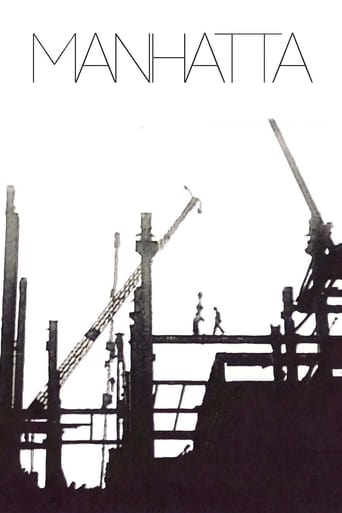framptonhollis
One of the earliest "city symphonies", and arguably one of the most groundbreaking avant garde films of the 1920's, 'Manhatta' is a lyrical, slow, and moving tribute to a great American city based loosely off of a Walt Whitman poem. The imagery isn't as intense and vibrant as that in many other films of a similar nature, whether they be other city symphonies or just other avant garde/experimental films in general, but there are several shots in here that definitely widened my eyes. The very specific positioning of the camera for certain angles helped give much of the short film a very epic feel. At some points, it even felt extremely futuristic and, to me, evoked some shots from Fritz Lang's legendary classic 'Metropolis'. It's only about twelve minutes, so any fan of experimental film might as well check it out as it is highly revolutionary and visually pleasing.
andtheballrolls
Preface: Due to the nature of such a short film, any valid review will contain some evidence of a "spoiler." This review is no exception.Paul Strand's "Manhatta" is more than just the simple, pioneering piece in early cinema. "Manhatta" is a representation of New York City through the eyes of a still photographer. Strand uses the format of motion picture to create a sense of life. Similar to his New York still photography, each moving image frames city life, angles, and other objects with semi-avant-garde detail. Strand's own "mentor," Alfred Stieglitz, greatly appreciated the new form of city photography, publishing it in "Camera Work" and in his gallery 291.In the movie, the blowing smoke, walking people, moving ships, and other objects in motion are what separate the motion picture from a photo album. Instead of portraying New York as an iconic, prosperous city, Strand has been able to portray New York City as an organism that contains a immigrant working class.In my opinion, "Manhatta" commands the respect of many early motion pictures, influencing many great, more popular films.
Cineanalyst
Here's the beginning of the city symphony film, which would include "Berlin: Symphony of a City" (1927) and "The Man with a Movie Camera" (1929). Although "Manhatta" doesn't contain the rapid rhythmic montage of some of the later city symphonies, it does have a sort of slower, poetic rhythm to it. It's discernible from a travelogue in that it has something to say about its city, other than it's a nice place to visit. The steady progression of images interloped with poetic intertitles taken from Walt Whitman produce the rhythm.From the still photographer Paul Strand and the painter and still photographer Charles Sheeler, their view of Manhattan is, of course, modern. The shots are of skyscrapers and the inter-workings of the city. One is Strand's 1915 still photograph "Wall Street" come to motion. The composition, camera placement and observation of light and shadow are striking throughout the short film, and they are reflective of the work by the filmmakers in other media. Sheeler and Strand had already transplanted modern, abstract and formal ideas from painting into still photography and with "Manhatta" they similarly redirected film.
DaveLB-3
Instead of having a filmmaker attempting to be painterly, this poetic gem boasts both a major painter (Sheeler) and a major photographer (Strand) collaborating.This is the earliest view of Manhattan we have that is neither simple-minded documentation nor backdrop to melodrama. The visuals are striking, and stand up well to later, more gimmicky, film realizations of what makes Skyscraper National Park so special.The Walt Whitman title cards would probably have worked better as voiceover narration in the sound era, but offer a strong romantic framework for the powerful imagery. A classic, not to be missed.
